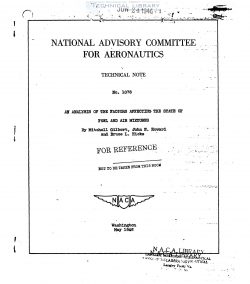naca-tn-1078
- Version
- 114 Downloads
- 1.09 MB File Size
- 1 File Count
- December 2, 2016 Create Date
- December 2, 2016 Last Updated
National Advisory Committee for Aeronautics, Technical Notes - An Analysis of the Factors Affecting the State of Fuel and Air Mixtures

The factors important in determining the state and the rate of
change of state of mixtures of liquid fuel, fuel vapor, and.dry air
are discussed with reference to basic physical variables such as
pressures, temperatures, and amounts present of liquid fuel, fuel
vapor, and air.
Data in the form of curves and tables are given to enable esti—_
mation of temperatures and other conditions required for complete
or partial vaporization of various fuels. An estimate is also made
of the maximum and minimum time for evaporation of different sizes
of fuel drops; the importance of knowledge of the factors affecting
vaporization time is indicated from this estimate. ‘
Knowledge of the physical state of the fuel-air mixture (that
is, the mixture quality) within the precombustion zones of a Jet-
propulsion burner and at the intake ports of multicylinder recipro-
cating engines is necessary in present aircraft-engine research. In
the Jet-propulsion burner research much work is being done in evalur
ating the performance of fuels. The variation in rate and completeness
of combustion.with different fuels cannot be completely understood
unless the vaporization factors are given their proper emphasis in '
explaining the processes leading to combustion. In the reciprocating-
engine field knowledge of mixture quality is needed for the correlation
of fuel knock ratings between.multicylinder engines and single-cyclinder
laboratory engines for studying the performance of various engine comp
ponents and for taproving fuel distribution to cylinders. The proper
evaluation of the effects of internal coolants in engines could be
materially aided by mixture—quality information, Methods of descrip-
tion of mixture quality are therefore worth while subjects of investi-
gation with regard to both conventional and Jet-propelled.power plants.
In principle, all physical properties of the mixture that influ-
ence the performance of individual engine cylinders and the character
of burning in Jet-propulsion units should be determined. Because of
the complex, unstable, and heterogeneous nature of the fuel-air “
mixture usually existing between the point of fuel injection and the
intake port or actual combustion zone, complete specification of
these physical properties is difficult and has seldom been tried.
Instead, so-called mixture temperatures and calculated equilibrium, ’
air-distillation temperatures have been used for estimating mixture
quality. Both methods are inadequate because important factors
affecting mixture quality and vaporization processes are neglected.
Measurements of true mixture temperatures are difficult because of
wet-bulb effects on the temperature-measuring device. Equilibriume
air-distillation temperatures are inadequate because they cannot
describe the dynamic process by which fuel-air mixtures are formed,
but only equilibrium states.
| File | Action |
|---|---|
| naca-tn-1078 An Analysis of the Factors Affecting the State of Fuel and Air Mixtures.pdf | Download |

Comment On This Post